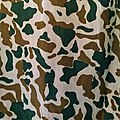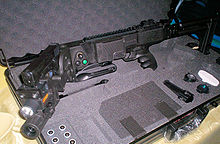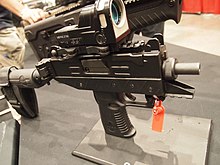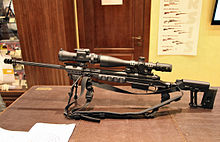People's Army of Vietnam Special Forces
| People's Army of Vietnam Special Forces | |
|---|---|
 People's Army of Vietnam Special Forces logo | |
| Founded | 19 March 1967 |
| Country | |
| Allegiance | Communist Party of Vietnam |
| Branch | |
| Type | Special operations force |
| Role | Covert operations Counter-terrorism Hostage rescue Direct action Deep reconnaissance Unconventional warfare Intelligence gathering High-value targets Counter narcotic operations Counter-proliferation Close protection |
| Size | 10,000 people |
| Garrison/HQ | Thanh Trì, Hà Nội |
| Motto(s) | Đặc biệt tinh nhuệ, Anh dũng tuyệt vời, Mưu trí táo bạo, Đánh hiểm thắng lớn
(Unique and elite; Heroic and superb; Ingenious and daring; Deadly attacks yield great victories) |
| Anniversaries | March 19, 1967 |
| Decorations | |
| Commanders | |
| Current commander | |
| Ceremonial chief | |
| Notable commanders | |
| Insignia | |
| Identification symbol | |
The People's Army of Vietnam Special Forces (Vietnamese: Binh chủng Đặc công) is the elite combat armed service of the People's Army of Vietnam, led by the General Staff of the Vietnam People's Army. It is uniquely organized, equipped, and trained with special fighting skills, bravery and heroism, resourcefulness and boldness to attack and destroy key enemy’s targets.
The VSF has the task of focusing on researching and advising the Ministry of Defence to build and develop Vietnamese special forces capabilities.[1][2]
History[]
Pre-history[]
In the 13th century, during the Mongol invasions of Vietnam, the Trần army developed a way of ambushing with small, elite forces, good at fighting on land, on rivers, and at sea. Trần Quốc Tuấn has directed: "Being reckless on the boat is not as good as stabbing under the boat, destroying the enemy's army is not as good as destroying the enemy's boat". Implementing that direction, General Yết Kiêu organized and trained Trạo Nhi teams consisting of strong and good swimmers who specialized in destroying the enemy's naval base. In many battles, the Trạo Nhi team secretly entered the naval base, burned the boat with flammable substances and dived into the muddy water, destroyed many Mongol troops in Chương Dương, Phả Lại, and Chí Linh and once captured them live the enemy general.[3][4]
In 1410, Trần Nguyên Hãn utilized the doctrine of "Quân cốt tinh, không cốt nhiều" ("The core of an army is its quality, not quantity") and organized a famous battle with nearly 200 insurgents, stripped naked and camouflaged, and secretly infiltrated the Xương Giang citadel, Việt Trì to attack the Ming army in the citadel.[5][6]
First Indochina War[]
On the Southern battlefield, France strengthened the construction of a system of posts around towns and cities and on important roads in order to encircle, separate and hinder the Viet Minh armed forces. Through many successful trials, especially the battle to destroy Bà Kiên bridge post in the night of March 18 and early morning, March 19, 1948, opened a new possibility to defeat the enemy in a solid entrenched position.[7]
In November 1949, Military Region 7 command held a symposium on fighting the watchtower with the participation of officers and soldiers who had participated in fighting the watchtower and proposed a new way of fighting the watchtower. With the FT wall-breaking weapon (Trái phá FT), on the night of March 21 to the morning of March 23, 1950, on the battlefield of Biên Hòa, 50 battle groups simultaneously used FT to attack 50 watchtowers, causing great confusion for the enemy. From this battle, the Biên Hòa Provincial Army and the General Staff of Military Region 7 held a conference to learn from experience and use commando tactics.[8]
The South focused on research and development, constantly perfecting commando tactics. Stemming from the combat mission and the enemy's goals, units in the South had a new development with an increasingly large scale. A commando battle is organized with 3 components: ground commando, water commando, and mobile special forces with the common organizational scale of team, battalion, standing at the base across strategic locations.
During the last period of the First Indochina War and during the Battle of Dien Bien Phu, the Viet Minh developed on the battlefields, had a knack for fighting in the enemy's rear, initially gained experience in synergistic warfare in the area. campaigns. The special forces fought the enemy on both front and rear. Some typical battles of the commando troops such as Phú Thọ bombing, Tân An bomb depot, Cát Bi airport, Gia Lam Airport.[9][10]
Vietnam War[]
After the 1954 Geneva Conference was signed, the Communist Party of Vietnam and army selected and sent special forces from the North to the South to build up forces and fight. In June 1958, the Southeast Command was established and the Eastern armed forces had a special commando company with the code name 60th Company. This was the first commando company in the South. Company 60, along with special commando groups and groups in the localities, began to attack Republic of Vietnam government buildings and posts.
In September 1962, specialized commando teams began to enter the southern battlefields, supplementing combat units in military zones and provinces. In the two years 1961 - 1962, 10 specialized commando companies, 1 mobile battalion with 1,122 men were reinforced for zone 5 and the South. The birth and rapid development of mobile and specialized commando forces in the North marked a new development in the organization of special forces troops.[11]
During the period of the implementation of the Staley–Taylor Plan, one of the most prominent features of special operations was that for the first time, participated in combat with the main army in special operations campaign quality and won many victories. Some typical battles during this period were the destruction of the Plây Cơ Rông commando base, the raid on Pleiku airport and the American barracks Holloway, the Brinks Hotel bombing, the Attack on USNS Card. The feats of North Vietnamese commandos in the period of counter-strategy Staley–Taylor Plan marked an important development of the art of combat behind hostile lines to destroy the enemy's forces the headquarters and center of war operations of the US-RVN.[12][13][14][15]
During the 1968 Tet Offensive, North Vietnamese commandos led the attack on ARVN headquarters and vital installations in most South Vietnamese cities, contributing to a 1968 Mậu Thân victory, creating a turning point in the Vietnam War.[16]
Present[]
The current ground special forces units consist of the 113th Commando Brigade (3 times being awarded the Hero of the People's Armed Forces in 1975, 1979, 2000), located in Vinh Phuc, the 198th Commando Brigade (established in 1974), located in Dak Lak, 429th Commando Brigade stationed in Binh Duong.
The current naval special forces unit include the 5th Commando Brigade stationed in Ninh Thuan under the Commando Command and the 126th Naval Commando Brigade.
The special task force currently have the , formerly based in Gia Lâm but now (M1 Brigade) stationed in Hanoi.

Commandos of Binh Chủng Đặc Công in a parade.

Commandos of Binh Chủng Đặc Công in joint training operation with Singapore.[17]
Uniform equipment[]
| Name | Image | Type | Origin | Notes |
|---|---|---|---|---|
| Night vision | ||||
| Night vision | Night-vision device | Manufactured locally.[18] | ||
| Helmets | ||||
| Bulletproof helmet | Combat helmet | Manufactured locally. It has been introduced in International Army Games's exhibition.[19] | ||
| Type A2 Helmet | Combat helmet | The PAVN's standard issue bump shell is a hard plastic replica of the PASGT helmets. It is used for training exercises and combat drill. | ||
| Utility Cover | Kepi | Standard issue soft cover, consisting of a four point front panel and an elastic backstrap. The cap's camouflage print is worn matching with field fatigues during patrols. | ||
| SSh-68 | 
|
Combat helmet | Limited use. | |
| SSh-40 | 
|
Combat helmet | Limited use. | |
| PASGT Helmet | 
|
Combat helmet | Limited use with Special Forces, Border Guards, and the Navy. They are gradually replacing older helmets in all branches of the Army. Most helmets are a Vietnamese-made version of the PASGT Helmet. Earlier models were imported from Israel.[20][21] | |
| M1 Helmet | 
|
Combat helmet | Limited use. | |
| Modular Integrated Communications Helmet | 
|
Combat helmet | Manufactured locally.[22] | |
| Type High Cut Helmet | 
|
Combat helmet | Manufactured locally.[22] | |
| Body equipment | ||||
| AG K53T Body Armour | Body armor | Manufactured locally.It has been introduced in International Army Games's exhibition.[19] | ||
| 7,62 K56 Body Armour | Body armor | Manufactured locally.It has been introduced in International Army Games's exhibition.[19] | ||
| AG K51T Body Armour | Body armor | Manufactured locally.It has been introduced in International Army Games's exhibition.[19] | ||
| Body Armour | Body armor | Limited use. Manufactured locally. NIJ level III[23] | ||
| Body Armour | Body armor | Modern battle uniform for standard Vietnamese infantry. It will be standard issue in the future. Manufactured locally at the Z176 factory.[1][2] | ||
| Marom Dolphin Fusion System | Body armor | [3] | ||
| Flak jacket | Body armor | Limited use by Anti riots units. | ||
| Tatical Vest | Tatical vest | Manufactured locally.[24] | ||
| Combat Leather Pads | Knee Pads | Standard Issued along with the new K20 Military Uniform.[25] | ||
| Camouflage patterns | ||||
| K-17 Woodland | 
|
Camouflage pattern | Former standard-issue camouflage for ground forces. Similar coloration to the K-07, there are also multiple variants for the other branches of the military.[26][27] | |
| K20 Pattern,
K21 Field Uniform[28] |

|
Camouflage pattern | Standard issue as of 2021, the PAVN's K20 Camouflage pattern was developed based on existing ERDL and K07 patterns, with more subdued coloration.[25] | |
| Modified Duck Hunter Pattern | 
|
Camouflage pattern | ||
| Thermal imaging anti-reconnaissance clothing | Camouflage pattern | It has been introduced in International Army Games's exhibition.[19] | ||
| Ghillie suit | 
|
Ghillie suit | Manufactured locally.It has been introduced in International Army Games's exhibition.[19] | |
Equipment[]
| Name | Image | Type | Origin | Notes | |
|---|---|---|---|---|---|
| Accessories | |||||
| ITL MARS | Red dot sight | Mounted on Uzi, AKM-1, IWI Tavor. | |||
| Meprolight m21 | Red dot sight | Mounted on Uzi, AKM-1, IWI Tavor, STV Rifles and IWI ACE | |||
| Night vision sight | Night vision sight | Mounted on Uzi, AKM-1, IWI Tavor, STV Rifles and IWI ACE.[29] | |||
| Small arms | |||||
| IWI Jericho 941 |  |
Semi-automatic pistol | |||
| K14-VN | Semi-automatic pistol | ||||
| TT-33 |  |
Semi-automatic pistol | |||
| CornerShot |  |
||||
| Shotgun | |||||
| Armsel Striker |  |
Shotgun | Limited use[30] | ||
| Sub machine gun | |||||
| Uzi |  |
Submachine gun | |||
| PM-63 |  |
Submachine gun | [31] | ||
| SN9P |  |
Submachine gun | |||
| Assault rifle | |||||
| STL-1A | Assault rifle | ||||
| AKS-47 |  |
Assault rifle | Early variant of the AK-47, featured a downward-folding metal stock similar to that of the MP 40. | ||
| AKMS |  |
Assault rifle | |||
| IWI Tavor |  |
Bullpup | |||
| STV | Assault rifle | ||||
| IWI ACE |  |
Assault rifle/Battle rifle | |||
| M-18 |  |
Carbine |
|
A version of the assault rifles improved by Vietnam from the CAR-15 XM177 series of spoils obtained after the Vietnam War. | |
| APS underwater rifle |  |
Underwater assault rifle | |||
| Light machine gun | |||||
| IWI Negev |  |
General-purpose machine gun/Squad automatic weapon | |||
| PKM |  |
General-purpose machine gun/Squad automatic weapon | |||
| RPK |  |
General-purpose machine gun/Squad automatic weapon | |||
| FN Minimi |  |
Light machine gun/Squad automatic weapon | [32] | ||
| Sniper rifle | |||||
| Orsis T-5000 |  |
Sniper rifle | [33] | ||
| WKW Wilk |  |
Anti-materiel rifle | |||
| IWI Galatz |  |
Semi-automatic sniper rifle | A derivative of the Galil ARM that is used in conjunction with high-quality 7.62×51mm NATO ammunition for consistent accuracy. | ||
| OSV-96 |  |
Anti-materiel rifle | |||
| VSK-94 |  |
Designated marksman rifle | [34] | ||
| Dragunov SVD |  |
Designated marksman rifle | A compact variant of the SVD was introduced In the early 1990s. | ||
| Grenade launcher | |||||
| Milkor MGL |  |
Revolver grenade launcher | |||
| OPL40M/T-40 |  |
Grenade launcher | Manufactured locally by Z111[35] | ||
| RPG-7 |  |
Rocket-propelled grenade launcher | Designated as B41 in Vietnam.[36] | ||
| Mortars | |||||
| STA-50 | Light mortars | Manufactured locally at the Z117 Factory.[37] | |||
Vehicles[]
| Vehicle | Image | Type | Origin | Notes |
|---|---|---|---|---|
| Ford F350 | 
|
Mobile Adjustable Ramp System | Mobile Adjustable Ramp System [38] | |
| BTR-60 | 
|
Armoured personnel carrier | ||
| BTR-152 | 
|
Armoured personnel carrier | ||
| Isuzu Forward | 
|
Medium transport truck | ||
| BRDM-2 | 
|
Armoured personnel carrier |
Aircraft[]
| Aircraft | Image | Type | Origin | Notes |
|---|---|---|---|---|
| Mil Mi-8 | 
|
Helicopter | ||
| Antonov An-2 | 
|
Military transport aircraft | Used for paratroopers training |
Notes[]
- ^ "Special Operation Force Arms - General introduction". Portal of the Ministry of Defence of the Socialist Republic of Vietnam.
{{cite web}}: CS1 maint: url-status (link) - ^ "Arms". Portal of the Ministry of Defence of the Socialist Republic of Vietnam.
{{cite web}}: CS1 maint: url-status (link) - ^ VCCorp.vn. "Quả đ���m thép 'Trạo nhi': Nỗi kinh hoàng ám ảnh hàng chục vạn quân Mông Nguyên trên đất Việt". soha.vn (in Vietnamese). Retrieved 2021-09-03.
- ^ "Sử dụng thuyền chiến trong lịch sử dựng nước". Báo Hải Quân Việt Nam. 2017-01-30. Retrieved 2021-09-03.
- ^ "Những câu nói lưu danh sử sách của Đức Thánh Trần". thanhpho.namdinh.gov.vn. Retrieved 2021-09-03.
- ^ "Kế sách giữ nước thời Lý - Trần". www.quansuvn.net. Retrieved 2021-09-03.
- ^ "Trận đánh tháp canh cầu Bà Kiên: Khai sinh lối đánh đặc công". baobinhduong.vn. Retrieved 2021-09-03.
- ^ "Tự chế trái phá FT". www.qdnd.vn (in Vietnamese). Retrieved 2021-09-03.
- ^ Mạo, Hữu (2017-06-01). "Meet the soldier left in the battle of Phú Thọ bomb depot 63 years ago". Website of the Party Committee of Ho Chi Minh City.
- ^ Mạnh, Thắng (2016-12-13). "Explosions in Gia Lam Airport". Quân Đội Nhân Dân.
- ^ "Special Operation Force Arms - The process of formation and development". Portal of the Ministry of Defence of the Socialist Republic of Vietnam. 2012-08-10.
{{cite web}}: CS1 maint: url-status (link) - ^ "Chiến thắng Plây Me". Báo Nhân Dân. Retrieved 2021-09-03.
- ^ "Chiến dịch tiến công Sa Thầy năm 1966: Lập thế trận dụ địch ra để tiêu diệt". www.tuyengiaokontum.org.vn. Retrieved 2021-09-03.
- ^ Tạ, Văn Sỹ (2018-01-07). "The story of the man who hit the Pleiku airport". Gia Lai Online.
- ^ "Vụ đánh bom cư xá Brinks năm 1964". Hình Ảnh Lịch Sử - Bộ sưu tập Hình Ảnh Lịch Sử Việt Nam và Thế Giới (in Vietnamese). Retrieved 2021-09-03.
- ^ "Đặc công, biệt đ���ng trong Tổng tiến công và nổi dậy Xuân Mậu Thân 1968". www.qdnd.vn (in Vietnamese). Retrieved 2021-09-03.
- ^ https://e.vnexpress.net/news/news/vietnam-s-special-forces-take-part-in-anti-terrorism-drill-in-singapore-3400172.html[dead link]
- ^ "200 thiết bị quân sự Việt Nam sản xuất được giới thiệu ở Army Games 2021". www.qdnd.vn.
- ^ a b c d e f "200 thiết bị quân sự Việt Nam sản xuất được giới thiệu ở Army Games". vnexpress.net.
- ^ "Mũ chống đạn của Quân đội Việt Nam chịu được đạn 9mm". netnews.vn. Retrieved 2019-04-16.
- ^ "Tìm hiểu các loại mũ sắt, mũ chống đạn của QĐNDVN". soha.vn (in Vietnamese). Retrieved 2019-04-16.
- ^ a b "Đặc nhiệm Việt Nam bắt kịp xu thế mũ chống đạn hàng đầu thế giới". Kienthuc.net.vn. 2020-12-10. Retrieved 2021-03-17.
- ^ "Cận cảnh áo giáp chống đạn 'Made in Việt Nam': đạt cấp III+ theo tiêu chuẩn Mỹ, chống đạn AK-47 ở khoảng cách 15m". genk.vn. 2018-09-03. Retrieved 2021-02-01.
- ^ https://www.qdnd.vn/quoc-phong-an-ninh/tin-tuc/200-thiet-bi-quan-su-viet-nam-san-xuat-duoc-gioi-thieu-o-army-games-2021-670219
- ^ a b "Việt Nam chính thức lựa chọn trang bị quân phục dã chiến K20 mới - BAOMOI.COM". m.baomoi.com. Retrieved 2021-02-17.
- ^ "[ẢNH] Quân phục ngụy trang "kỹ thuật số" của Việt Nam có những ưu điểm nào?". Báo điện tử An Ninh Thủ Đô. 2018-07-07. Retrieved 2019-04-16.
- ^ "Ảnh: Quân phục dã chiến mới của QĐND Việt Nam". Kienthuc.net.vn. 2017-11-16. Retrieved 2019-04-16.
- ^ Thời sự Quốc phòng ngày 22/2/2021: Quân đội đảm bảo quân trang cho chiến sĩ mới, retrieved 2021-02-24
- ^ "Chiến sĩ QĐND VN được trang bị kính nhìn xuyên đêm". ZingNews.vn. 5 October 2013.
- ^ https://kienthuc.net.vn/quan-su/khau-sung-shotgun-lien-thanh-cuc-ky-doc-dao-cua-quan-doi-viet-nam-1494510.html
- ^ https://kienthuc.net.vn/quan-su/ly-do-pm-63-la-tieu-lien-so-1-cua-dac-cong-viet-nam-826782.html
- ^ https://kienthuc.net.vn (2013-11-27). "Khám phá kho súng máy của bộ đội Việt Nam (kỳ 2)". trithuccuocsong.vn. Retrieved 2021-09-03.
{{cite web}}: External link in|last= - ^ "[ẢNH] Trinh sát đặc nhiệm Việt Nam được trang bị súng bắn tỉa hàng đầu của Nga". Báo Điện tử An ninh Thủ đô (in Vietnamese). 2021-02-02. Retrieved 2021-09-03.
- ^ https://kienthuc.net.vn (2020-09-09). "Súng bắn tỉa giảm thanh cực độc của Việt Nam lần đầu lộ diện". trithuccuocsong.vn. Retrieved 2021-09-03.
{{cite web}}: External link in|last= - ^ https://anninhthudo.vn/anh-chiem-nguong-sung-phong-luu-kep-nong-doc-dao-viet-nam-tu-che-tao-post376643.antd
- ^ RPG.
- ^ VCCorp.vn. "Súng cối và đạn cối triệt âm 50 mm Việt Nam có gì đặc biệt?". soha.vn (in Vietnamese). Retrieved 2019-06-15.
- ^ https://soha.vn/quan-su/kham-pha-xe-thang-dot-kich-chuyen-dung-cua-bo-doi-dac-cong-vn-20150401231856046.htm
- Orders, decorations, and medals of Vietnam
- Military units and formations of the People's Army of Vietnam

